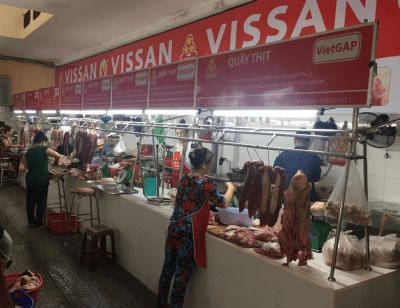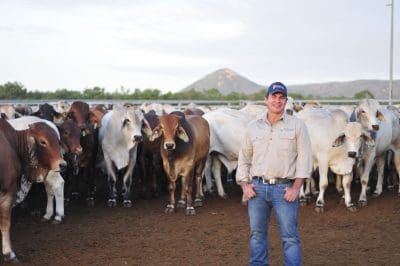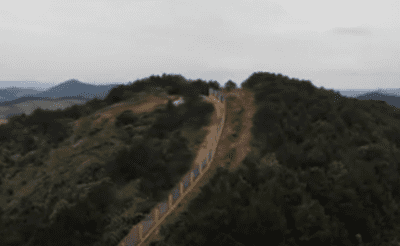AUSTRALIA’S cattle export trade to Vietnam has grown quietly but surely in recent years, to the surprising point where it almost surpassed Indonesia as Australia’s highest value cattle export market last year.

Stall holders at a Vietnamese wet market get ready for the early morning rush. Picture: Dr Ross Ainsworth
In volume terms Indonesia easily remains Australia’s largest cattle export market, importing 467,656 cattle in 2020, predominantly light cattle for feedlots.
That compared with 297,721 head to Vietnam, about 80 percent of which were heavy, 500kg plus cattle ready for immediate processing.
The higher weight and price of each individual animal to Vietnam meant that despite taking fewer cattle it ended the year with an annual trade value of $524 million, just a shade behind Indonesia at $534 million.
Contributing to that result was the fact that Indonesia’s numbers were the lowest in eight years, due largely to an inability by importing Indonesian feedlots to absorb record high Australian cattle prices, while Vietnam’s imports represented a six year high.
The Vietnam market and its growth over recent years has received comparatively little fanfare or attention, but has clearly progressed a long way from where it was six years ago when it was attracting headlines for all the wrong reasons.
Dr Michael Patching had only just taken over the role as Meat & Livestock Australia’s market development manager for Vietnam in 2015 when reports of Australian cattle being struck with sledgehammers in a Vietnamese abattoir became national news back home.
That was a year in which demand for Australian cattle in Vietnam had exploded, with exports doubling in a single year to 362,248 head in 2015, a pace of growth that came far too quickly for the market to handle, or at least in a way that assured the welfare of all exported Australian cattle.
As reports of Australian cattle being mistreated in Vietnam surfaced, Australian cattle exporters to the country met and committed to accepting more stringent animal welfare conditions and higher levels of scrutiny of their customer supply chains, over and above the requirements of the Australian Government’s mandatory Exporter Supply Chain Assurance System.
The statistics show that in the next two years Australian cattle export volumes to the market dropped substantially to 197,353 head in 2016 and then 165,172 head in 2017 as customers who were not prepared to abide by rules preventing Australian cattle being removed from their supply chains were ousted and work increased with remaining customers to improve staff training in animal welfare, cattle monitoring traceability systems and investments in facility upgrades.
Since that time the trade has begun to grow again, this time in a more measured, gradual way with fewer but larger customers with better facilities. Exports in 2018 increased to 202,215 head, growing to 267,663 head in 2019 and 297,721 head last year.
Working closely with Australian exporters and Vietnamese importers along the way through his roles with MLA and LiveCorp has been Dr Patching, a Murdoch University and University of Edinburgh trained veterinarian with master’s degree qualifications in international animal welfare, ethics and law.
After six years in the role, Singapore-based Dr Patching is now moving on to start his own consultancy business where he will focus on filling a gap in trade facilitation work for companies seeking to develop commercial agriculture market opportunities in the ASEAN region.
His replacement in the MLA role has not yet been publicly confirmed.
Shift to more feeder cattle exports to Vietnam likely
Australia’s cattle export trade to Vietnam is now subject to more regulations and conditions than any other market.
But despite the higher level of oversight Australian exporters have to comply with in order to supply cattle to the market, he believes the trade is poised for substantial future growth.
He also foresees a greater shift towards Vietnam importing a higher percentage of feeder cattle in coming years.
But, in an interview with Beef Central, Dr Patching said a large part of that growth being achieved will depend on Australian industry’s ability to continue investing in technical help for Vietnamese lot feeders and processors, and on building animal welfare compliance.
Conditions in Vietnam have clearly improved, and 100 percent compliance is an impossible goal for any industry.
Still, occasional problems persist, with the Department of Agriculture website listing four reported ESCAS breaches in Vietnam in 2020, three of which were self-reported by exporters. The issues relate to Australian cattle being moved to facilities outside exporter supply chains, and claims in two reports of cattle being “flooded”, a cruel practice in which cattle are forced to intake large volumes of water by hose prior to slaughter in the belief it will add weight to saleable meat. One of the reports of cattle being moved out of supply chains was found by the Department to be a minor breach of ESCAS, the other three are still being investigated.
“Five years in Asia, and especially Vietnam, is a long time”
To reduce the risk of further incidents, LiveCorp and Meat & Livestock Australia have been working with the Vietnamese Government to develop animal welfare laws consistent with Australian expectations for the treatment of cattle exported overseas, which will apply to all cattle in the country.
The trade to Vietnam has matured in many respects and relationships between Australian exporters and their import customers were now very different to when he arrived six years ago, Dr Patching said.
“We went from this really immature, fragmented, opportunistic type trading situation to customers stepping up and building more into their business,” he said.
“They are reliable trading partners, they are investing further down the supply chain, building their own abattoirs and getting to almost closed loop supply chains, and getting to a point where they have either begun or at least are talking about investing in improving those abattoirs to be high value processing type facilities, to produce chilled beef.
“In only six years we have gone discussing the most basic animal welfare principles to conversations with these guys about butcher training and how they can get more value out of their carcases, which is a pretty big shift in a short period of time.
“Five years in Asia, and especially in Vietnam, is a long time.”
Vietnam market could go ‘one of two ways’ – but 500,000 cattle per year possible
Asked where he believed Australia’s cattle and beef export trade to Vietnam is likely to be in another five years’ time, he predicted it could go one of two ways.

Australian cattle exporter Patrick Underwood, ACE, inspecting high grade Brahman steers selected for shipment to Vietnam last year.
If things continue as they are, the market would continue to rapidly mature, he believed, with increasing volumes of boxed beef product being imported.
One major change he foresees in coming years is the high price of Australian cattle triggering a greater shift toward the import of feeder cattle.
“Vietnam has always been a slaughter cattle market because importers wanted throughput through their facilities and cash flow,” he said.
“With the price of Australian cattle, what I think we’re going to see now for the next couple of years is a shift to feeding cattle to get better margins.
“At the moment it is still about 80 percent slaughter cattle. If that shifts to say 60 percent with the other 40 percent coming through as feeders then the market will be able absorb some of those price fluctuations or dollar changes etc, because it will have gains from the feeding margins as well.”
However, changes in the competitive landscape could lead to a different outcome.
It is possible, he says, that Brazil will gain access for its beef into Vietnam at some point in the future. If this happens Brazilian beef could undercut other sources of meat on price and ‘take the bottom of the market’, which could also hurt domestic Vietnamese production in the process.
Approval of cattle imports from Brazil to Vietnam has also been discussed as an increasing possibility in recent years and remains on the agenda.
This approval is perhaps more likely to happen, but, in a similar way that talk of cattle exports from Mexico to Indonesia is panning out, barriers such as costs and logistics and freight distances remain serious hurdles that could make cattle exports from Brazil to Vietnam difficult to achieve in practice.
“Probably the biggest one to flag is that if (Vietnamese importers) don’t continue to mature their production and processing from a commercial perspective, so their ability to get feed gains from feedlots and to get value gains from higher processing and different value adding beyond the traditional channels, then the market could regress in six years and maybe become not so significant.
“But if they continue to grow those capabilities and have businesses that are willing to continue to invest, then we have got a 400,000-500,000 head annual market.”
What Australian industry needs to do
To increase the chances of that happening he said the Australian industry is continuing to progress work to help lot feeders and processors in Vietnam to improve their technical and business knowledge and to drive animal welfare compliance.
The Livestock Global Assurance Program (LGAP), now in the first stages of being physically rolled out in Vietnam, was a further strong step in that direction.
Overall, it was important for Australia to improve its understanding of markets like Vietnam, Dr Patching said.
There was a general perception in Australia that a large proportion of the beef that is processed from Australian cattle exported to Vietnam is transhipped and on sold across the border into China.
However, this was almost entirely incorrect, he said.
There was just not enough beef being processed in Vietnam to meet the demands of the local population.
At the same time, China has also been doing everything it can in recent years to shut down any grey trade that previously existed across its borders in response to rising disease threats such as African Swine Fever and COVID, evidenced by the walls China is building along its borders with Vietnam and Myanmar.
“China has been really big on shutting down those unofficial channels so I would be reasonably confident to say there is very little beef or cattle going across the border into China now,” Dr Patching said.
“I would say there’s none, and that is probably a massive shift that has happened in the last six years.
“Vietnam was the largest importer of Indian buffalo meat in the world but not very much of it stayed in Vietnam, almost all of it went over into China. What we’re seeing now with the trade statistics is that Vietnam volumes have plummeted for Indian buffalo meat, and even that isn’t being transhipped via Vietnam to China anymore.”
‘We need to stop thinking of Vietnam as a trading ground’
One key challenge for market development work in Vietnam surrounds the high level of customer fragmentation within the market which made it very difficult to work with customers in a collective way. Work to date has largely had to be done with each company individually.
“That is not a great return on investment or a way to effect mass change, so as an industry we need to find a way to break through that,” he said.
“It is always a challenge because no companies want to share their information or developments with anyone else, but if the market really wants to evolve we really need to find new ways to break through that conversation.
“We also need to stop thinking about Asia as a trading ground. Finding the right business partners to trade with, be it live animals or boxed product is difficult, and therefore when things become too difficult people take the easiest route which is just to trade based on price.
“But by doing that we’re undermining ourselves. We’re not a commodity country, we don’t have commodity products, we can’t trade on price when we have got so many other cheap alternatives out there that we’re competing with.
“We need to be focusing more on value of product and not volume of product.”
Official trade statistics, which are currently reported only in volume terms, do not help this cause and should include trade value, Dr Patching suggests.
His overall message was that Vietnam is essentially a “really good market” for both Australian cattle and boxed beef.
A key part of this was because Vietnam has a strong market-driven economy where companies are largely free to trade without undue Government interference, and where businesses have a strong sense of entrepreneurialism and are willing to invest to seize opportunities.


